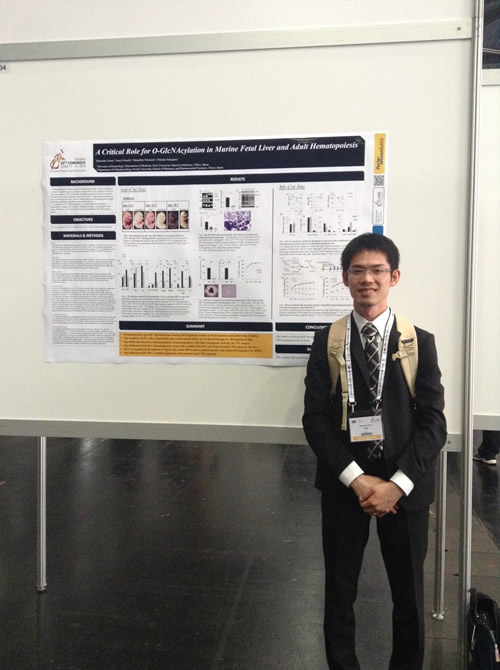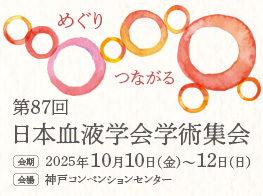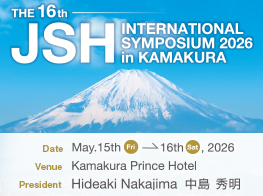
名前:相馬 俊介【慶應義塾大学医学部血液内科】
発表日時:2015年6月12日
発表形式:ポスター
Title:
A CRITICAL ROLE FOR O-GLCNACYLATION IN MURINE FETAL LIVER AND ADULT HEMATOPOIESIS
Authors:
Shunsuke Soma* 1, Yumi Fukuchi2, Shinichiro Okamoto1, Hideaki Nakajima1
Affiliations:
1Division of Hematology, Department of Medicine, Keio Univeisity School of Medicine,
2Department of Pathophysiology, Hoshi University School of Pharmacy and Pharmaceutical Sciences, Tokyo, Japan
Abstract
Background:
Posttranslational modifications such as phosphorylation or glycosylation are crucial for regulating protein function. Among these, glycosylation of serine or threonine residues with O-linked N-acetylglucosamine (O-GlcNAcylation) by O-linked N-acetylglucosamine Transeferase (OGT) is particularly important, as this modification regulates various cellular processes through numerous targets including signaling molecules or transcription factors. Dysregulation of O-GlcNAcylation is critically linked to metabolic or degenerative diseases (i.e. diabetes, Alzheimer disease), tumorigenesis and aging. However, a role of O-GlcNAcylation in hematopoiesis still remains elusive.
Aims:
To investigate the role of O-GlcNAcylation by Ogt in normal hematopoiesis.
Methods:
We utilized Ogt conditional knockout mice (Ogt-cKO) to delineate the role of O-GlcNAcylation in hematopoietic system. To accomplish hematopoietic-specific or inducible deletion of Ogt, Ogt-cKO mice were crossed to Vav-Cre transgenic (Tg) or Mx-Cre Tg mice, respectively. Since Ogt is located on X-chromosome, Ogtflox/Y or Ogtflox/flox mice were considered to be equivalent.
Results:
Since both Ogtflox/flox Vav-Cre+ and Ogtflox/Y Vav-Cre+ mice were embryonic or perinatal lethal, we analyzed E14.5 fetal liver cells (FLs) to examine the effect of Ogt loss in FL hematopoiesis. Quantitative RT-PCR and western blot analysis showed that Ogt-mRNA and OGT protein were absent in Ogtflox/Y Vav-Cre+ or Ogtflox/flox Vav-Cre+ FL cells, indicating that floxed-alleles created a null mutation. Interestingly, the number of FL cells was remarkably decreased in Ogtflox/Y Vav-Cre+ or Ogtflox/flox Vav-Cre+ embryos as compared to the wild-type (WT) counterparts. In contrast, the percentage of lineage-Sca-1+c-kit+ (LSK) cells was significantly increased in Ogtflox/Y Vav-Cre+ or Ogtflox/flox Vav-Cre+ FLs. Surprisingly, these Ogt-deficient LSK cells completely lacked clonogenic activity in methylcellulose culture in vitro, and a few surviving cells did not form secondary colonies in serial replating assays. Furthermore, when 3,000 LSK cells from either Ogt+/YVav-Cre+ or Ogtflox/YVav-Cre+ were transplanted into lethally irradiated recipient mice along with 200,000 recipient-type whole BM cells, Ogtflox/YVav-Cre+ donor-derived cells were scarcely detectable in peripheral blood(PB) of recipient mice at 3 weeks after transplantation, while more than 50% of PB cells were donor-derived in mice recieving Ogt+/YVav-Cre+ LSK cells. These data suggest that Ogt is critical for proliferation, differentiation and self-renewal of FL hematopoietic progenitors (HPCs). We next examined Ogtflox/Y Mx-Cre+ and Ogt+/Y Mx-Cre+ mice to investigate the role of Ogt in adult hematopoiesis. Ogt deletion was initiated via five intraperitoneal injections of polyinosinic-polycytidylic acid (pI-pC) at dose of 400 ㎍/body, and then complete blood cell counts were monitored every 2 weeks. Interestingly, the number of white blood cells, red blood cells and platelets were decreased over time in Ogt-deleted mice. At four weeks after pI-pC injection, the percentages of hematopoietic stem cells (HSCs) (CD48-LSK, CD150+CD48-LSK) in Ogt-deleted mice were significantly decreased as compared to those of WT mice. We then evaluated competitive repopulating activity of Ogt-deficient cells. 1,000,000 bone marrow (BM) cells from either Ogtflox/Y Mx-Cre+ or Ogt+/Y Mx-Cre+ mice (CD45.2+) were transplanted with the equal number of competitor cells (CD45.1+CD45.2+) into lethally irradiated CD45.1+ recipient mice. 4 weeks after transplantation, pI-pC was administered to the recipient mice to delete floxed alleles. The result showed that the percentage of Ogt-deleted cells was remarkably decreased at 2 weeks after pI-pC injection and it progressively decreased over time. These data suggest that Ogt is essential for competitive and long-term repopulating capacity of BM-HSCs.
Summary/Conclusion: The O-GlcNAcylation by Ogt plays a critical role for maintaining homeostasis of FL and BM hematopoiesis in mice.
EHA2015参加レポート
この度、20th Congress of Eupopean Hematology Associationの発表にあたって、Travel Awardに採用していただきありがとうございました。今回は音楽の街ウィーンのMessezentrum Vienna開催されました。伝統的な重厚な石造りの建物が多い中、ガラスとコンクリートでできた近代的な建物でした。連日30℃を超える真夏並みの気候の中、会場は冷房が効いていて快適に過ごすことができました。今回が初めての国際学会だったため、行く直前は期待とともに不安に思うことも多々ありました。しかし、終わってみると非常に有意義で大変な刺激になりました。参加者のほとんどがヨーロッパからと思われ、女性の参加者が非常に多く、約半数以上は女性であったように思います。Presidential Sympsiumの演者も5人中3人が女性でした。勝手な想像ですがヨーロッパでは血液学が女性に人気のある分野なのかもしれません。
さて、私は現在糖鎖修飾と造血の関わりをマウスモデルと用いて解析を行っております。このマウスは核や細胞質に存在するタンパクにO-GlcNAc修飾を付与する唯一の酵素であるO-linked N-acetylglucosamine transeferase(OGT)をノックアウトしたものです。O-GlcNAc修飾を受けるタンパクは約4,000以上ともいわれ、その修飾と調節は細胞の生存に必須であると思われます。近年、O-GlcNAc修飾の異常と疾患の関わりが多数報告されるようになり、各種癌細胞ではOGTの発現やO-GlcNAc修飾を受けたタンパクが増えていることが知られており、その増加の程度は予後との相関も示されています。癌代謝において重要な役割を担っていること示唆されますが、造血領域ではどのような役割を担っているのか明らかにされていません。今回、糖鎖修飾をノックアウトすることで造血系にどのような影響かでるかが発表の内容でした。ポスターのディスカッションの時間には、決して多くはないものの何人かが興味を持って内容を見ていただいたのが大変うれしく思いました。一方で、詳細なメカニズムがまだわかっておらず、臨床的にどのように応用できるのかが詰められておらず、やはりそういったところを指摘されました。将来的には造血器腫瘍でO-GlcNAc修飾が関わっているかどうかを明らかにし、治療のターゲットになりえるかどうかを探っていきたいと思っております。
また、自分の発表以外の時間においては基礎研究のセッションを中心に参加しました。特に印象に残ったのはMDS in nicheのセッションでした。AMLと異なりMDS細胞は免疫不全マウスに移植しても生着できないことが知られていましたが、間葉系幹細胞(MSC)と一緒に骨髄内へ移植することで高い生着率が得られることを報告していました。これはAMLに近いhigh risk MDSだけでなく、5q-症候群などのlow risk MDSでも再現されていました。MDSにおいてはその病態を維持するのにnicheが重要であることが直接証明されたということは個人的に非常に興味深いと思いました。その他のセッションでも非常に活発に議論がされており大変刺激になりました。
最後になりますが、平素よりご指導いただいている慶應義塾大学医学部血液内科の岡本真一郎教授、中島秀明准教授に心より感謝致します。また、このような機会をくださった日本血液学会国際委員会の先生方や事務局の皆様、誠にありがとうございました。




